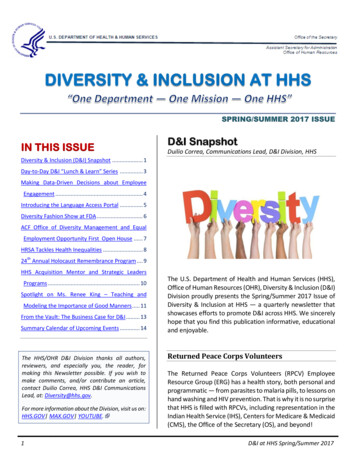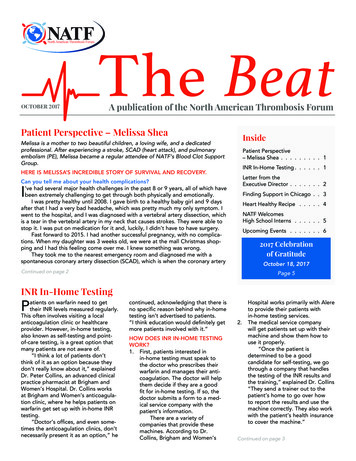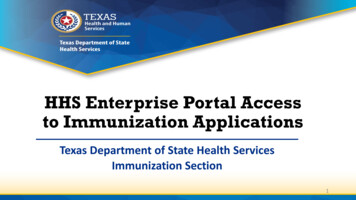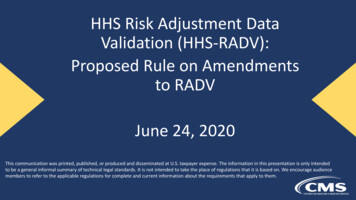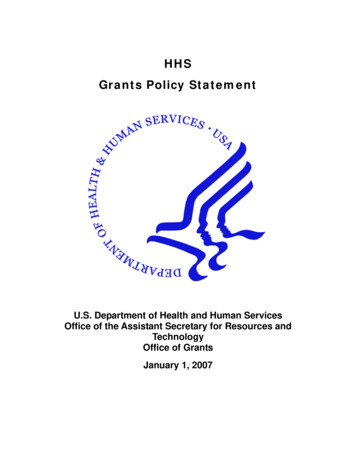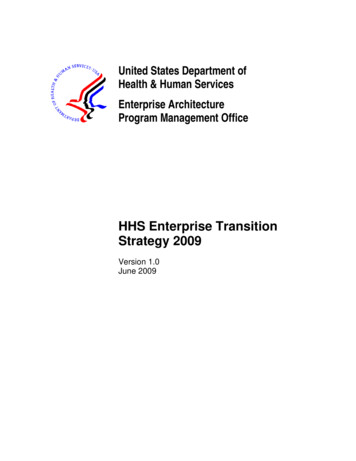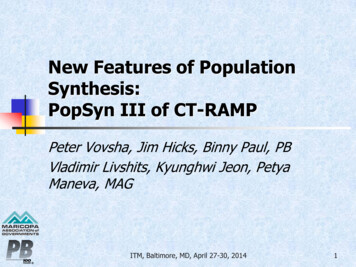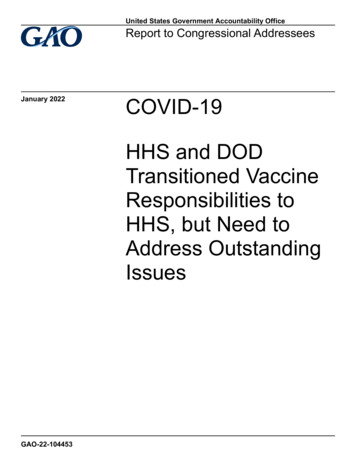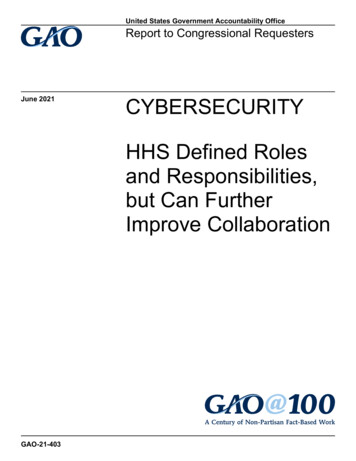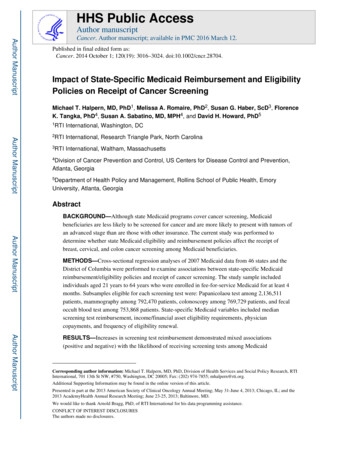
Transcription
HHS Public AccessAuthor manuscriptAuthor ManuscriptCancer. Author manuscript; available in PMC 2016 March 12.Published in final edited form as:Cancer. 2014 October 1; 120(19): 3016–3024. doi:10.1002/cncr.28704.Impact of State-Specific Medicaid Reimbursement and EligibilityPolicies on Receipt of Cancer ScreeningMichael T. Halpern, MD, PhD1, Melissa A. Romaire, PhD2, Susan G. Haber, ScD3, FlorenceK. Tangka, PhD4, Susan A. Sabatino, MD, MPH4, and David H. Howard, PhD5Author Manuscript1RTIInternational, Washington, DC2RTIInternational, Research Triangle Park, North Carolina3RTIInternational, Waltham, Massachusetts4Divisionof Cancer Prevention and Control, US Centers for Disease Control and Prevention,Atlanta, Georgia5Departmentof Health Policy and Management, Rollins School of Public Health, EmoryUniversity, Atlanta, GeorgiaAbstractAuthor ManuscriptBACKGROUND—Although state Medicaid programs cover cancer screening, Medicaidbeneficiaries are less likely to be screened for cancer and are more likely to present with tumors ofan advanced stage than are those with other insurance. The current study was performed todetermine whether state Medicaid eligibility and reimbursement policies affect the receipt ofbreast, cervical, and colon cancer screening among Medicaid beneficiaries.METHODS—Cross-sectional regression analyses of 2007 Medicaid data from 46 states and theDistrict of Columbia were performed to examine associations between state-specific Medicaidreimbursement/eligibility policies and receipt of cancer screening. The study sample includedindividuals aged 21 years to 64 years who were enrolled in fee-for-service Medicaid for at least 4months. Subsamples eligible for each screening test were: Papanicolaou test among 2,136,511patients, mammography among 792,470 patients, colonoscopy among 769,729 patients, and fecaloccult blood test among 753,868 patients. State-specific Medicaid variables included medianscreening test reimbursement, income/financial asset eligibility requirements, physiciancopayments, and frequency of eligibility renewal.Author ManuscriptRESULTS—Increases in screening test reimbursement demonstrated mixed associations(positive and negative) with the likelihood of receiving screening tests among MedicaidCorresponding author information: Michael T. Halpern, MD, PhD, Division of Health Services and Social Policy Research, RTIInternational, 701 13th St NW, #750, Washington, DC 20005; Fax: (202) 974-7855; mhalpern@rti.org.Additional Supporting Information may be found in the online version of this article.Presented in part at the 2013 American Society of Clinical Oncology Annual Meeting; May 31-June 4, 2013; Chicago, IL; and the2013 AcademyHealth Annual Research Meeting; June 23-25, 2013; Baltimore, MD.We would like to thank Arnold Bragg, PhD, of RTI International for his data programming assistance.CONFLICT OF INTEREST DISCLOSURESThe authors made no disclosures.
Halpern et al.Page 2Author Manuscriptbeneficiaries. In contrast, increased reimbursements for office visits were found to be positivelyassociated with the odds of receiving all screening tests examined, including colonoscopy (oddsratio [OR], 1.07; 95% confidence interval [95% CI], 1.06-1.08), fecal occult blood test (OR, 1.09;95% CI, 1.08-1.10), Papanicolaou test (OR, 1.02; 95% CI, 1.02-1.03), and mammography (OR,1.02; 95% CI, 1.02-1.03). Effects of other state-specific Medicaid policies varied across thescreening tests examined.CONCLUSIONS—Increased reimbursement for office visits was consistently associated with anincreased likelihood of being screened for cancer, and may be an important policy tool forincreasing screening among this vulnerable population.KeywordsAuthor ManuscriptMedicaid; access to health care; cancer screening; health insurance reimbursement; health caredisparities; colonoscopy; mammography; Papanicolaou testINTRODUCTIONMedicaid, a joint state-federal government health insurance program for certain low-incomeindividuals, pays for medical care for a substantial percentage of the US population (anestimated 67.7 million individuals in 2010).1 Between 2009 and 2010, Medicaid enrollmentgrew by an estimated 6.2% and is expected to continue to increase over the next severalyears if states chose to expand Medicaid eligibility under the Patient Protection andAffordable Care Act.2Author ManuscriptMedicaid programs in all states and the District of Columbia (DC) provide coverage forbreast, cervical, and colorectal cancer screening.3 However, coverage does not guaranteereceipt of these services. Previous studies have reported that Medicaid beneficiaries wereless likely to be screened for cancer than individuals with private insurance,4-6 and weremore likely to present with advanced-stage cancers than patients enrolled in privateinsurance or Medicare.7-11Author ManuscriptWithin limits set by the federal government, states can establish their own Medicaideligibility requirements and reimbursements.12 Medicaid reimbursements differ substantiallyamong states and are usually below Medicare reimbursement levels13; these lowreimbursements may affect access to cancer screening services. Although findings regardingthe association between physician reimbursement and the provision of medical care servicesin general are mixed,14-18 low Medicaid reimbursement rates and required office visitcopayments may decrease access to needed medical care services.7,19-22 Increased Medicaidreimbursements are associated with increased access to a usual source of care and the receiptof services for both children23,24 and adults.25State-level variations in Medicaid eligibility policies may also affect health service use,including cancer screenings. For example, several Medicaid policies (eg, frequency ofMedicaid renewal) may affect how long beneficiaries remain enrolled in Medicaid or remainwith established providers, both of which have been positively correlated with receipt ofbreast and colorectal cancer screening.26,27Cancer. Author manuscript; available in PMC 2016 March 12.
Halpern et al.Page 3Author ManuscriptIt is important to understand how terms of coverage (ie, eligibility requirements) andpayments offered to providers affect receipt of preventive care services. The current studyexamined the association between Medicaid reimbursements for cancer screening tests andoffice visits and financial eligibility requirements and the receipt of breast, cervical, andcolorectal cancer screening.MATERIALS AND METHODSData and Study PopulationAuthor ManuscriptAuthor ManuscriptThe current study is a cross-sectional analysis of the 2007 Medicaid Analytic eXtract(MAX) claims and enrollment data, which was the most recent year of data available at theinitiation of this study. The Centers for Medicare and Medicaid Services maintains MAXdata for all 50 states and DC.28 The study sample included individuals from 46 states andDC who were aged 21 years to 64 years, not dually eligible for Medicare, and enrolled infee-for-service Medicaid for at least 4 months. Dual Medicare-Medicaid enrollees andenrollees in capitated managed care plans were excluded because their complete service usemay not be reported in MAX.29 Because beneficiaries with limited Medicaid enrollmentduring the study year would have fewer opportunities to use services, beneficiaries with 4months of enrollment were excluded. However, because many individuals are enrolled inMedicaid for relatively short periods of time,30 beneficiaries were not required to have a fullyear of enrollment. Beneficiaries who were pregnant, had 1 claims with a cancerdiagnosis, or resided in a long-term care facility were excluded. The Indian Health Serviceprovides comprehensive health services to approximately 2 million of the estimated 3.4million American Indians/Alaska Natives in the United States.31 Whether the Indian HealthService consistently bills Medicaid for cancer screenings is unknown. Therefore, allAmerican Indian/Alaska Native Medicaid enrollees were excluded given the likelihood ofunderascertaining receipt of cancer screenings. Because most fee-for-service enrollees inArizona, New Mexico, and Nevada were American Indian and the populations remaining inthese states after applying this exclusion criterion were atypical compared with the studypopulations of other states, these 3 states were excluded. Maine was also excluded becausethe state did not report physician and outpatient claims in 2007.Author ManuscriptFrom the sample meeting these inclusion criteria, subsamples for each screening test weredefined based on age and sex. Very few claims for flexible sigmoidoscopy or barium enemawere included in the Medicaid data, and therefore these procedures were not examined. Alist of the Current Procedural Terminology (CPT) and International Classification ofDiseases, Ninth Revision (ICD-9) codes used to identify screening-related claims is shownin the online supporting information. For all screening tests except mammography, the samecodes are used for screening and diagnostic tests, which prevents differentiation betweencancer screenings and diagnostic procedures.Independent Variables: State-Specific Reimbursement Rates and Medicaid PoliciesFor each state, the reimbursement rate for each screening test was defined as the medianamount paid on outpatient and inpatient claims. Because multiple CPT and ICD-9 codeswere used for the majority of screening tests examined, the state-specific reimbursement forCancer. Author manuscript; available in PMC 2016 March 12.
Halpern et al.Page 4Author Manuscripta test was calculated as the median amount paid in each state for all the identified CPT andICD-9 procedure codes associated with that test. Codes used to determine state-specificscreening rates and reimbursements are presented in the online supporting information.Because there were very few claims that provided separate reimbursements for professionaland technical components of screening tests, reimbursements included in the current studywere for the global reimbursement (ie, combined technical and professional componentreimbursements) for the included screening test.Author ManuscriptBecause of the significant difference in reimbursement for film versus digitalmammography, separate reimbursement rates for each type of mammogram were calculatedas well as for film and digital mammograms billed by facilities (eg, hospitals) andnonfacilities (eg, physician's offices). Because screening tests are generally either providedor ordered during an office visit, reimbursement for office visits was also considered usingthe state-specific median reimbursement for office visits of moderate severity (CPT code99213). State variation in fecal occult blood test (FOBT) reimbursement was minimal(range, 1- 7), and therefore state-specific FOBT reimbursement was not included in theFOBT regression model.Medicare's methodology of accounting for regional differences in the costs of medicalservices was used by adjusting reimbursement for mammography and office visits by the2007 Medicare Geographic Adjustment Factor and reimbursement for colonoscopy by the2007 Hospital Wage Index.Author ManuscriptState-specific Medicaid eligibility requirements hypothesized to influence cancer screeningincluded income and financial asset thresholds, physician copayments for preventiveservices (required or not required), and frequency of eligibility renewal (12 months or 12months from the initial enrollment date) (see online supporting information). Policyinformation was derived from the Henry J. Kaiser Family Foundation.32-34 Because incomeand financial asset requirements vary by Medicaid eligibility group (parents, blind/disabled,or medically needy) within a state, these variables were determined using beneficiaries’eligibility categories. “Less restrictive” income eligibility requirements were defined asallowing a maximum income of 100% of the federal poverty level (FPL) for parents, 75%of the FPL for the blind/disabled, and 54% of the FPL for the medically needy. Parents wereassigned as experiencing a “less restrictive” financial asset policy if they did not have tomeet an asset test. Because blind/disabled and medically needy populations are subject toasset tests in all states, a state's policy was considered “less restrictive” if these populationswere allowed assets 2000.Author ManuscriptDependent Variable: Cancer Screening Test ReceiptThe outcome of interest was receipt of a colonoscopy, film or digital mammogram, FOBT,or Papanicolaou (Pap) test. Select CPT codes and ICD-9 procedure codes were used toidentify claims for these cancer screening tests (see online supporting information). Statespecific rates for receipt of each screening test are presented in the online supportinginformation. Analyses examine receipt of cancer screenings in 2007 and do not reflectadherence to testing intervals recommended in current cancer screening guidelines.Furthermore, because screening test rates were based only on 2007 Medicaid claims dataCancer. Author manuscript; available in PMC 2016 March 12.
Halpern et al.Page 5Author Manuscript(which, for many beneficiaries, involved Medicaid enrollment for less than the full calendaryear), the screening rates presented in the current study are likely to be lower than thosefrom individual surveys or analyses of claims data for individuals enrolled for an entire year.Statistical AnalysesAuthor ManuscriptMultivariable logistic regression was used to measure associations between state-specificMedicaid reimbursement and policy variables with receipt of cancer screening tests. Toaccount for the clustering of beneficiaries within a state, generalized estimating equationsassuming an exchangeable working correlation and robust standard errors were used to fitlogistic regression models. All regressions controlled for age, age squared, sex, race/ethnicity, urban residence, Medicaid eligibility category, number of inpatient stays, numberof chronic conditions (conditions and codes listed in the online supporting information), andstatewide screening rates for the corresponding type of cancer as a partial control forunmeasured state-level factors (from the 2008 Behavior Risk Factor Surveillance System;2007 estimates were not available).35 To facilitate interpretation, odds ratios were scaled bya dollar amount equal to 20% of the national median reimbursement for that screening testor office visit.Author ManuscriptFor mammography, 2 additional covariates were included (the ratio of film to digitalmammogram claims among Medicare enrollees in the state and the ratio of facility tononfacility mammogram claims in the state's Medicaid claims) to control for state variationsin the availability of digital versus film mammography and the rates at which different typesof providers billed for mammograms. An additional 9 states (Delaware, Massachusetts,Missouri, Nebraska, New York, Ohio, Utah, West Virginia, and Wyoming) were excludedfrom mammography analyses because these states had no claims for digital mammographyor lacked both facility and nonfacility claims, thus preventing the creation of theseindependent variables. Maryland was excluded from this analysis because the medianreimbursement was more than twice that of the next highest state and 6 times the nationalMedicaid reimbursement.All analyses were weighted by the fee-for-service months an individual was enrolled inMedicaid during 2007 and were performed using SAS statistical software (SAS Institute Inc,Cary, NC). Study procedures were approved by RTI's Institutional Review Board.RESULTSAuthor ManuscriptBeneficiary characteristics are summarized in Table 1. The percentage of Medicaid enrolleesresiding in states with less restrictive income requirements ranged from 42% to 57%, and thepercentage in states with less restrictive asset requirements ranged from 18% to 27%.Approximately 80% of beneficiaries resided in states requiring Medicaid renewal every 12months and approximately 60% resided in states requiring physician copayments forpreventive care services. Within the age-appropriate and sex-appropriate samples, 26% ofpatients received a Pap test, 20% received a film or digital mammogram, 6% received acolonoscopy, and 4% received a FOBT during the study year.Cancer. Author manuscript; available in PMC 2016 March 12.
Halpern et al.Page 6Author ManuscriptTable 2 summarizes screening test and office visit reimbursements (state-specific rates arepresented in the online supporting information). National median screening testreimbursements ranged from 24 for a Pap test to 271 for colonoscopy; the median officevisit reimbursement was 37.Association Between Reimbursement Rates and Cancer ScreeningAuthor ManuscriptIn multivariate regression models, small but significant associations were observed betweenMedicaid reimbursement rates and several screening tests. However, these associations werenot in a consistent direction. A 20% increase in screening test reimbursement (based on thenational median reimbursement) was associated with a 1.6% increase in the odds ofreceiving colonoscopy and an 0.8% decrease in the odds of receiving Pap test (Table 3).Increased reimbursements for digital mammography at facilities, digital mammography atnonfacilities, and film mammography at nonfacilities were associated with 1.2%, 4.0%, and1.7% increases, respectively, in the odds of receiving mammography, whereas increasedreimbursement for film mammography at facilities (the most frequent type ofmammography claim) was associated with a 5.4% decrease in the odds of receivingmammography (Table 4).In contrast to these mixed results, increased reimbursement for office visits was significantlyand consistently found to be positively associated with the likelihood of receivingcolonoscopy, FOBT, Pap test, and mammogram. A 20% increase in office visitreimbursement was associated with increases in the odds of screening ranging from 2.2% formammography to 8.7% for FOBT.Association Between Medicaid Policies and Cancer ScreeningAuthor ManuscriptAuthor ManuscriptThe effects of Medicaid policy variables were not uniform across the screening testsexamined. Beneficiaries in states with less restrictive income eligibility had higher odds ofreceiving Pap tests (P .001) but lower odds of receiving FOBT tests (P .001). There wasno significant relationship noted between income eligibility and receipt of colonoscopy ormammography. Less restrictive financial asset policies were found to be negativelyassociated with the odds of receipt of FOBT and positively associated with the odds ofreceipt of all other screening tests (all P .001); these positive associations ranged from7.4% to 12.2% increases in the odds of receiving these screenings. Beneficiaries in statesrequiring Medicaid renewal 12 months after initial enrollment had higher odds ofreceiving an FOBT (P .03) or mammogram (P .001) and lower odds of receiving a Paptest (P .001). The effect size of the association of required renewal at 12 months on theodds of mammography, 11.8%, was substantially larger than other effects on other screeningtests for this policy factor. Residing in states requiring a copayment for physician serviceswas found to be negatively associated with the odds of receiving a colonoscopy, Pap test, ormammogram and was positively associated with the odds of receiving a FOBT (all P .001).Cancer. Author manuscript; available in PMC 2016 March 12.
Halpern et al.Page 7Author ManuscriptDISCUSSIONThe current study examined the effects of Medicaid reimbursement rates and eligibilityrequirements on receipt of cancer screening tests among Medicaid enrollees. Increasedreimbursements for screening tests were associated with generally small and inconsistentchanges (ie, both positive and negative) in the likelihood of receiving screening testswhereas increased office visit reimbursements were associated with a higher likelihood ofreceiving screening for all tests examined. Given the large number of adults enrolled inMedicaid, even small increases in screening rates can translate into large numbers ofadditional individuals screened. However, the larger effect sizes and consistently positiveassociation observed between office visit reimbursement and receipt of screening testssuggest that offices visits may be a more relevant policy tool with which to increase cancerscreenings compared with test reimbursements.Author ManuscriptLess restrictive Medicaid financial asset policies were associated with an increased odds ofreceiving all screening tests except FOBT. However, the relationships between receipt ofscreening and other Medicaid policies examined, including income eligibility, frequency ofeligibility renewal, and physician copayments, varied across the screening tests.Author ManuscriptIncreasing reimbursement levels for screening tests may expand the supply of facilities (eg,laboratories, imaging facilities) providing services for Medicaid beneficiaries, but increasingpayments for office visits may increase access to and/or the supply of providers ordering thetests. There are substantial barriers for Medicaid enrollees to receive outpatient physiciancare36-38; the results of the current study are consistent with previous studies indicating thathigher Medicaid reimbursements for office visits are associated with increased receipt ofhealth care services, including preventive services.23-25 Medicaid reimbursement rates arealso associated with physician participation in Medicaid and acceptance of new Medicaidpatients.20,39-42 The Patient Protection and Affordable Care Act includes provisionsintended to increase Medicaid provider capacity and improve accessibility for Medicaidpopulations, including the requirement that states increase Medicaid reimbursements forcertain services provided by primary care providers to Medicare rates in 2013 and 2014. Thefindings of the current study indicate that this requirement may increase the receipt of cancerscreening tests.Author ManuscriptIncreased cancer screening among Medicaid enrollees may result in the increased detectionof cancers at earlier stages.43 Sommers et al recently reported that expanded Medicaideligibility was associated with significantly decreased all-cause mortality.2 As states expandMedicaid eligibility, it will be important to track state-specific changes in Medicaidenrollment, reimbursement rates, and eligibility requirements, and their impact on cancerscreening, diagnosis at an early stage, and survival among individuals diagnosed withcancer.The current study includes several limitations. The analyses reflect only the receipt ofscreening tests billed to Medicaid; services rendered without billing or those billed to otherinsurers (eg, Veterans Affairs) were not captured in the data. Because screening test rateswere based only on 2007 Medicaid claims data (which, for many beneficiaries, involvedCancer. Author manuscript; available in PMC 2016 March 12.
Halpern et al.Page 8Author ManuscriptAuthor ManuscriptMedicaid enrollment for less than the full calendar year), the screening rates presented in thecurrent study are likely to be lower than those from individual surveys or analyses of claimsdata for individuals enrolled for an entire year. In addition, because the same CPT codes areused for all screening and diagnostic tests except for mammography, no differentiation couldbe made between cancer screenings versus diagnostic procedures as a follow-up tosymptoms or previous abnormal screening results. However, it is likely that a majority of thetests were for screening results rather than diagnosis because many more individualsundergo screening and because individuals diagnosed with cancer were excluded from thecurrent study. Furthermore, although physicians may not submit codes for screening testsperformed for all patients, and in particular FOBT may not be submitted due to lowreimbursement, physicians in fee-for-service environments need to submit procedure codesto get paid for services provided; therefore, we anticipate that physicians will submit claimsfor screening tests for the majority of patients screened. Because the vast majority ofscreening test claims provided only the global reimbursement for each screening test (ie,there were very few claims providing separate reimbursements for professional andtechnical components), we were unable to examine the association between professional andtechnical component reimbursements and rates of screening tests. The current study did notinclude patients in capitated managed care plans; state-level differences in policies regardingMedicaid managed care may result in differences between state populations included in thestudy sample.Author ManuscriptA recently published study reported that breast, cervical, and colorectal cancer screeningsare not covered in all states for Medicaid beneficiaries.44 However, a report for the KaiserFamily Foundation and other information have indicated that these cancer screenings arecovered in all states and DC.3,45,46 Furthermore, substantial numbers of claims andreimbursements were identified for all these screening tests in all states included in thecurrent study (see online supporting information). Therefore, we believe that these cancerscreenings were covered for Medicaid beneficiaries in all included states during the studyperiod. The current study is a cross-sectional analysis, and unmeasured state-level factorsmay affect results. Statewide screening rates for the corresponding type of cancer wereincluded as a partial control for unmeasured state-level factors. Because previous work hasindicated limited changes in Medicaid cancer screening reimbursements across years,47 thiscross-sectional comparison is likely to demonstrate more policy variation than a longitudinalstudy of state reimbursement rates over time. Multiple previous studies have examined theimpact of a variety of disparities on cancer screening using cross-sectional comparisons.48-51Finally, adherence to 2007 recommendations for cancer screenings with multiyear intervalscould not be examined.Author ManuscriptAs Medicaid programs continue to evolve, these findings may assist policy makers inexamining ways in which reimbursements for cancer screening tests and office visits andeligibility policies could be used to address barriers to access to care and improve the uptakeof cancer screening services.Supplementary MaterialRefer to Web version on PubMed Central for supplementary material.Cancer. Author manuscript; available in PMC 2016 March 12.
Halpern et al.Page 9Author ManuscriptAcknowledgmentsFUNDING SUPPORTFunded by the Centers for Disease Control and Prevention contract 200-2008-27958 task order 15. The findingsand conclusions in this report are those of the authors and do not necessarily represent the official position of theCenters for Disease Control and Prevention.REFERENCESAuthor ManuscriptAuthor ManuscriptAuthor Manuscript1. Truffer, CJ.; Klemm, JD.; Wolfe, CJ., et al. 2011 Actuarial Report on the Financial Outlook forMedicaid. Office of the Actuary, Centers for Medicare and Medicaid Services, United StatesDepartment of Health and Human Services; Washington, DC: 2011.2. Sommers BD, Baicker K, Epstein AM. Mortality and access to care among adults after stateMedicaid expansions. N Engl J Med. 2012; 367:1025–1034. [PubMed: 22830435]3. The Henry, J. Coverage of Preventive Services for Adults in Medicaid. The Henry J. Kaiser FamilyFoundation; Washington, DC: 2012. Kaiser Family Foundation. Kaiser Commission on Medicaidand the Uninsured. /8359.pdf. [March 31,2014]4. Ioannou GN, Chapko MK, Dominitz JA. Predictors of colorectal cancer screening participation inthe United States. Am J Gastroenterol. 2003; 98:2082–2091. [PubMed: 14499792]5. Potosky AL, Breen N, Graubard BI, Parsons PE. The association between health care coverage andthe use of cancer screening tests. Results from the 1992 National Health Interview Survey. MedCare. 1998; 36:257–270. [PubMed: 9520952]6. Ward E, Halpern M, Schrag N, et al. Association of insurance with cancer care utilization andoutcomes. CA Cancer J Clin. 2008; 58:9–31. [PubMed: 18096863]7. Baker LC, Royalty AB. Medicaid policy, physician behavior, and health care for the low-incomepopulation. J Hum Resources. 2000; 35:480–502.8. Chen AY, Schrag NM, Halpern M, Stewart A, Ward EM. Health insurance and stage at diagnosis oflaryngeal cancer: does insurance type predict stage at diagnosis&quest. Arch Otolaryngol HeadNeck Surg. 2007; 133:784–790. [PubMed: 17709617]9. Chen AY, Schrag NM, Halpern MT, Ward EM. The impact of health insurance status on stage atdiagnosis of oropharyngeal cancer. Cancer. 2007; 110:395–402. [PubMed: 17562558]10. Halpern MT, Ward EM, Pavluck AL, Schrag NM, Bian J, Chen AY. Association of insurancestatus and ethnicity with cancer stage at diagnosis for 12 cancer sites: a retrospective analysis.Lancet Oncol. 2008; 9:222–231. [PubMed: 18282806]11. O'Malley CD, Shema SJ, Clarke LS, Clarke CA, Perkins CI. Medicaid status and stage at diagnosisof cervical cancer. Am J Public Health. 2006; 96:2179–2185. [PubMed: 17077390]12. Ramirez de Arellano, AB.; Wolfe, SM.; Public Citizen Health Research Group. [March 31, 2014]Unsettling Scores: A Ranking of State Medicaid Programs. 2007. res.pdf.13. Zuckerman S, Williams AF, Stockley KE. Trends in Medicaid physician fees, 2003-2008. HealthAff (Millwood). 2009; 28:w510–w519. [PubMed: 19401290]14. Armour BS, Pitts MM, Maclean R, et al. The effect of explicit financial incentives on physicianbehavior. Arch Intern Med. 2001; 161:1261–1266. [PubMed: 11371253]15. Chaix-Couturier C, Durand-Zaleski I, Jolly D, Durieux P. Effects of financial incentives onmedical practice: results from a systematic review of the literature and methodological issues. Int JQual Health Care. 2000; 12:133
We would like to thank Arnold Bragg, PhD, of RTI International for his data programming assistance. CONFLICT OF INTEREST DISCLOSURES The authors made no disclosures. HHS Public Access Author manuscript Cancer. Author manuscript; available in PMC 2016 March 12. Published in final edited form as:

